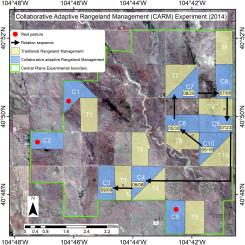Agricultural Systems ( IF 6.1 ) Pub Date : 2021-04-10 , DOI: 10.1016/j.agsy.2021.103139 G. Cheng , R.D. Harmel , L. Ma , J.D. Derner , D.J. Augustine , P.N.S. Bartling , Q.X. Fang , J.R. Williams , C.J. Zilverberg , R.B. Boone , D. Hoover , Q. Yu

|
Context
Understanding how grazing management decisions influence the productivity and composition of rangeland plant communities is essential for the development of effective strategies to sustainably produce multiple ecosystem goods and services. Informed with experimental measurements, simulation models can advance our understanding and stewardship of rangeland ecosystems.
Objective
Our main objective was to evaluate the APEX (Agricultural Policy/Environmental eXtender) plant growth modules and grazing animal selectivity in simulating forage production using experimental data collected from both traditional season-long grazing and adaptive rotational grazing management on western rangelands. Specifically, we evaluated APEX's capability to simulate forage productivity and its response to soil types and climate conditions under grazing management options.
Methods
Capitalizing on a comparative field study with 20 large pastures (> 123 ha each), APEX modifications were evaluated by comparing simulated forage production with experimental data. The field study evaluated traditional grazing (season long grazing on a single pasture) and an alternative grazing system that utilized collaborative adaptive rangeland management with stakeholders engaged in decision making (such as when and where to rotate a single herd). APEX was modified to include rotational grazing based on a user-defined sequence and automatic rotational grazing based on user-defined forage grazing limits and minimum/maximum grazing durations.
Results and conclusions
The APEX model was able to simulate the relative differences in forage production between grazing treatments, across years, and among soil types; however, APEX underestimated forage production in 2015 and 2017 due to overestimating drought stress for the warm season perennial grass functional group. Simulation of grazing management scenarios showed that the collaborative adaptive management decision criteria resulted in grazing durations that produced more forage than consistent 7- or 14-day rotation intervals.
Significance
These modifications were needed to capture the complexity of semiarid environments and thus enhance APEX to better assess grazing management decisions on forage production in regions such as the Western US Great Plains.
中文翻译:

评估APEX修改以模拟美国西部大草原的牧草管理决策支持的牧草生产
语境
理解放牧管理决策如何影响牧场植物群落的生产力和组成对于开发可持续生产多种生态系统产品和服务的有效策略至关重要。借助实验测量,模拟模型可以增进我们对牧场生态系统的了解和管理。
客观的
我们的主要目标是使用从西部牧场的传统的季节性放牧和适应性轮牧管理中收集的实验数据,评估APEX(农业政策/环境扩展)植物生长模块和放牧动物的选择性,以模拟草料生产。具体来说,我们评估了APEX在放牧管理选项下模拟草料生产力及其对土壤类型和气候条件的响应的能力。
方法
利用对20个大型牧场(每个> 123公顷)的比较田间研究的成果,通过将模拟草料生产与实验数据进行比较来评估APEX的改良。现场研究评估了传统放牧(在单个牧场上长期放牧)和使用协作自适应牧场管理的替代性放牧系统,利益相关者参与决策(例如何时和在何处轮流放牧)。对APEX进行了修改,使其包括基于用户定义的顺序的轮转放牧和基于用户定义的草料放牧限制以及最小/最大放牧持续时间的自动旋转放牧。
结果与结论
APEX模型能够模拟放牧处理之间,多年之间以及土壤类型之间草料生产的相对差异。然而,由于高估了多年生暖季草功能群的干旱压力,APEX低估了2015年和2017年的牧草产量。放牧管理方案的仿真显示,协作自适应管理决策标准导致放牧时间长于连续7天或14天轮作间隔而产生的草料更多。
意义
需要进行这些修改以捕获半干旱环境的复杂性,从而增强APEX,以更好地评估美国西部大平原等地区牧草生产的放牧管理决策。











































 京公网安备 11010802027423号
京公网安备 11010802027423号